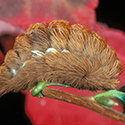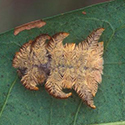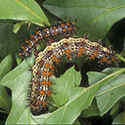Stinging and Venomous Caterpillars
Stinging caterpillars don’t sting with a stinger the way wasps or bees do, they have stinging hairs called urticating hairs. Urticating hairs are barbed hairs that easily break off the caterpillar’s body when the caterpillar is brushed against and can embed in a person or animal’s skin. Once in your skin these hairs cause sudden or gradually building pain depending on the specific caterpillar. On top of their irritating hairs, many stinging caterpillars also release a toxin on contact with the spines, which can add to the pain and may even be a health concern for some people. Urticating hairs can be especially irritating when they get into your eye.
Saddleback Caterpillar Acharia stimulea

These caterpillars get their name from their appearance. Saddleback caterpillars are brown on the front and back ends and the middle of the caterpillar is green with a brown oval (the border is usually bordered with white). Fully grown caterpillars are about 2 cm long. These caterpillars have stinging hairs in a row along each side as well as some on their front and back ends. Spines easily break of an can embed deeply into skin. Stings from these caterpillars can cause intense burning, inflammation, and red blanching. Additionally spines contain a toxin that can cause rashes of round, red, swelling welts that itch, and even tissue damage. Medical attention may be necessary for more severe reactions.
Saddleback caterpillars feed on a variety of plants including maples, hibiscus, palms, and crapemyrtle.
Puss Caterpillar/Southern Flannel Moth Megalopyge opercularis

These caterpillars are covered in soft hairs that seem like fun to touch — but fight the urge! Beneath those soft hairs are stiff spines attached to poison glands. When touched, the poisonous spines break off in the skin and cause severe pain. Puss caterpillars are 2.5 cm long and covered with gray to brown hairs that conceal its head and mouthparts. From its back this caterpillar has a tail that extends beyond its body.
There are two puss caterpillar generations a year in Florida; one in spring and another in fall. These caterpillars feed on a large variety of plants but are most commonly found on citrus, oaks, and elms. (Photo: Sturgis McKeever; Georgia Southern University; Bugwood.org)
Io Moth Caterpillar Automeris io

Io moth caterpillars grow to be 6.5 cm long; they are pale green with a white and a red strip down the length of their bodies. The parts of these caterpillars you want to be weary of are the yellow or green fleshy protrusions that are tipped in black and extend from the back of the caterpillar. The stinging spines are hollow, easily break off, and can embed deeply into skin. After contact a sudden stinging or burning sensation begins and the affected area may begin to itch and turn red. Pain should begin to decline after a couple hours and swelling declines after about 8 hours. Allergic reactions may occur and symptoms should be closely monitored.
Io moth caterpillars feed on a variety of host plants including hibiscus, elms, maples, wisteria, roses, azaleas, and willows.
Hag Caterpillar Phobetron pithecium

Hag caterpillars, or monkey slugs, come in shades of brown; they have stinging hairs in pairs of lateral curved spines that vary in length. The spines have toxin glands at their base, the toxin is released when the spines make contact with skin. Symptoms vary in severity to include burning or stinging, itching, redness, and inflammation. Allergic reactions are possible but not common. There is conflicting information on whether this caterpillar stings. Severity can vary for each individual.
These caterpillars feed on a variety of woody plants including oaks, dogwood, and apple.
Buck Moth Caterpillar Hemileuca maia

Buck moth caterpillars have a dark form and a light form; both forms have dark, lateral rows of multi-branched spines along their backs. Spines have a toxin gland at the base that is released when spines break off into the skin. Spines cause sudden stinging redness and swelling in the affected area. Symptoms can last anywhere from a day to over a week. The dark form is more common, it’s black with tiny white dots while the light form is white with a reddish head. These large caterpillars can reach 6.5 cm.
Host plants include oak and willow species.
Spiny Oak-Slug Caterpillar Euclea delphinii

Spiny oak-slug caterpillars have a range of colors but can generally be identified by their oval, stout bodies, and their abundance of spiny protrusions. These caterpillars have two to four clusters of spines protruding from the rear of its body. They get to be about 2 cm long and also have clusters of spines that surround the edge of the body. Spines are hollow with a toxin gland at the base. Stings from this caterpillar are milder than the stings of other stinging caterpillars. Symptoms can include a burning or stinging sensation, redness, and inflammation.
Spiny oak-slug caterpillars feed on a variety of woody plants including oak, willow, and cherry species.
